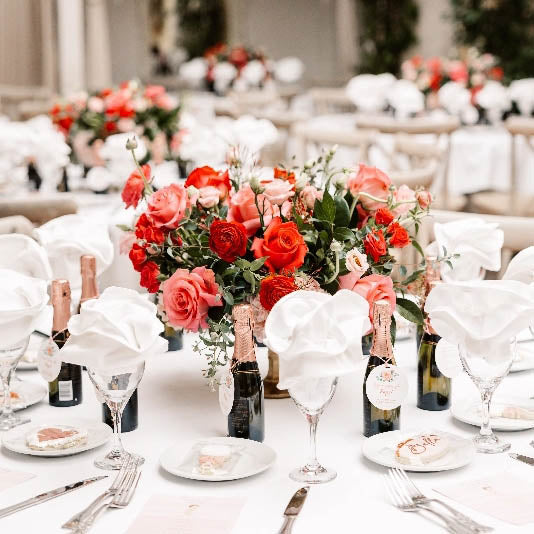
New on the Blog: Symbolism and Significance of June Flowers
June, the month of blooming flowers and vibrant colors, is when nature is at its most splendid. It is no wonder that this period has been associated with the celebration of flowers. June flowers come in a wide variety, each with its unique beauty and meaning. In this blog, we will delve into the origin, historical context, and diverse uses of these captivating blooms.
Spray Rose: Delicate Elegance
With its delicate petals and elegant appearance, the spray rose adds a touch of beauty to any arrangement. These miniature roses originated from the Mediterranean region and have been cherished for their charm and sophistication. In the language of flowers, spray roses symbolize grace, innocence, and admiration.
In addition to its aesthetic charm, the spray rose has been used in traditional medicine for its potential health benefits. Its petals and hips contain vitamin C and antioxidants, making it a source of immune-boosting and anti-inflammatory properties. The rose has been utilized in various forms, including teas, tinctures, and essential oils, to promote skin health, relieve sore throat, and support overall well-being.
Sweet Pea: Fragrant and Lovely
The sweet pea, known for its delicate fragrance and colorful blooms, traces its roots to Southern Italy. This flower has long been associated with delicate pleasures and tender sentiments. Sweet peas symbolize blissful pleasure, gratitude, and lasting friendship. Their presence in bouquets and floral arrangements brings a sense of joy and nostalgia.
The sweet pea is not commonly known for its medicinal properties and should be used cautiously due to potential toxicity. However, in traditional medicine, specific varieties of sweet peas have been used cautiously in homeopathic remedies in extremely diluted forms for conditions such as skin irritations and minor respiratory discomfort.
Peony: Abundance and Prosperity
The peony, a majestic and luxurious flower, has a rich history dating back to ancient Chinese culture. This extravagant bloom symbolizes wealth, honor, and prosperity. Peonies have been a symbol of good fortune and a favorite in wedding bouquets for their lush beauty and symbolism of a happy marriage.
This bloom, particularly the root, has a history of use in traditional Chinese medicine for its potential medicinal properties. Peony root has been valued and used in herbal formulations and teas to address conditions such as pain, inflammation, and immune-related imbalances.
Ranunculus: Radiant and Charming
The ranunculus, with its intricate layers of petals and vibrant hues, is a visual delight. Originating from Asia, this enchanting flower symbolizes charm, attractiveness, and radiant beauty. Ranunculus has been a popular choice for weddings and special occasions, adding a touch of elegance and sophistication to any floral arrangement.
Ranunculus contains compounds with potential medicinal properties, although it is essential to note that some species of ranunculus are toxic and should not be ingested. In traditional medicine, certain species have been used in controlled and highly diluted forms to address conditions such as joint discomfort, skin irritations, and minor wounds.
Scabiosa: Symbol of Admiration
Scabiosa, also known as the pincushion flower, is a unique and intriguing bloom with a central dome surrounded by delicate petals. This flower has been associated with admiration, purity, and grace. Scabiosa's striking appearance and symbolic meaning make it a meaningful choice for expressing admiration and appreciation.
This pillowy flower has been historically associated with various medicinal uses, such as digestive discomfort, respiratory issues, and skin irritations. However, caution is advised, as certain species may have toxic properties.
Asclepias: Enchanting and Ethereal
Asclepias, commonly known as milkweed or butterfly weed, is a whimsical and ethereal flower with vibrant colors that attract butterflies. This flower symbolizes transformation, resilience, and beauty in adversity. Asclepias adds a touch of enchantment to garden landscapes and serves as a vital host plant for monarch butterflies.
It has also been utilized in herbal remedies for its potential expectorant and diaphoretic properties, making it a choice for addressing respiratory conditions and fever. However, as with all medicinal plants, proper identification and dosage are crucial due to potential toxic effects.
Conclusion
By exploring the symbolism and historical significance of these diverse June flowers, we gain a deeper appreciation for the beauty and meaning they carry. Each bloom, from the delicate spray rose to the enchanting asclepias, offers a unique story to tell and enriches our understanding of the natural world. Whether used in bouquets, celebrations, or as a source of inspiration, June flowers continue to captivate our hearts and minds with their beauty and symbolism.
Stay tuned for more captivating articles by The Hidden Garden exploring the wonders of nature and the stories behind seasonal flowers.
****These brief blurbs highlight the traditional medicinal properties associated with each of these diverse and captivating flowers. It's important to note that if considering the use of any plant for medicinal purposes, consultation with a qualified healthcare professional or herbalist is essential to ensure safety and efficacy. The Hidden Garden is not liable for any adverse reactions or consequences if individuals choose to consume natural or herbal products.








